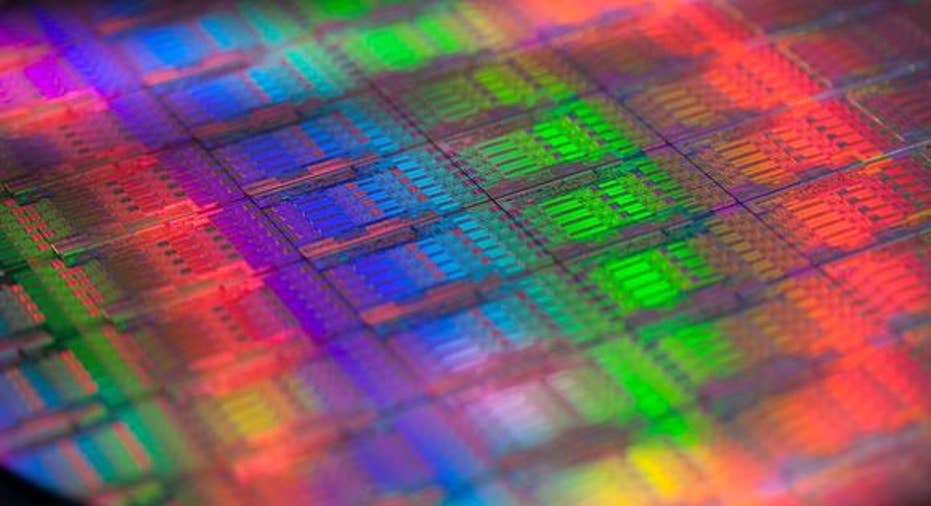Understanding Intel Corporations Inventory Situation

A wafer of chips. Image credit: Intel.
In a recent column published in Seeking Alpha, Bill Maurer notes that PC chip giant Intel entered the first quarter of 2016 with "inflated inventory" levels. These high inventories, coupled with the potential for PC sales to come in weaker during 2016 than Intel had originally anticipated, led Maurer to caution that Intel may experience some gross profit margin pressure going forward.
To expand upon this a little more, if Intel ends up needing to cut chip production to keep its internal inventories healthy, this leads to a decline in factory utilization. Sub-optimal factory utilization means that the significant fixed costs associated with running a chip fab (equipment depreciation, electricity use, personnel, etc.) are spread across fewer wafers, leading to an effective increase in cost-per-wafer.
At any rate, in the comments section of this article, a few users challenged Maurer's assertions, citing comments from Intel management on the call that "inventory levels were healthy."
This criticism, I believe, stems from a fundamental misunderstanding of the two different types of "inventory" that Intel management is talking about. I'd like to clear up this confusion.
Internal inventories versus channel inventoriesThere are different types of "inventories" that investors should be aware of. First there's Intel's own internal inventories. This represents the raw materials, chips that are still being manufactured, and chips that are finished. You can see these figures in the following table from Intel's form 10-K filing:
|
(In millions) |
Dec 26, 2015 |
Dec 27, 2014 |
|---|---|---|
|
Raw materials |
$532 |
$462 |
|
Work in process |
$2,893 |
$2,375 |
|
Finished goods |
$1,742 |
$1,436 |
|
Total inventories |
$5,167 |
$4,273 |
Source: Intel form 10-K filing.
In addition to Intel's own inventories, there's a concept known as "channel inventory." This simply refers to the stock of chips that Intel's partners have on hand. Remember that Intel sells chips to large PC manufacturers, PC component resellers, server builders, and so on.
If the inventory levels at these customers are too high relative to end product demand, then those customers may have to take some time to "burn off" this inventory and Intel winds up under-shipping parts relative to PC demand.
Conversely, if demand is better than expected (or if supplies had previously been tight), then low channel inventories relative to end demand could mean that Intel would need to "refill" the channel by shipping more than end demand for a period of time.
Clearing up the confusionNow that the distinction between internal inventories and channel inventories has been cleared up, it's pretty easy to understand the seemingly "contradictory" information referred to at the beginning of the article.
Intel indicated that its own internal inventories were greater than expected due to a combination of factors (yield improvements, weaker PC demand, etc.) but that channel inventories at its PC partners were "healthy."
In a nutshell, this means that Intel has more inventory than it would like but, at the time of Intel's most recent earnings call, its PC partners didn't have too much or too little.
What this means for the companyIf PC demand doesn't change significantly from what Intel had originally expected as of the last earnings call, then there's not much to get worked up about. Intel said that it by the second half of the year, it will "bring inventory levels down" without a negative impact to gross profit margins.
However, if PC unit demand winds up significantly worse than expected, there is the risk that Intel will cut its factory loadings in order to keep internal inventory levels healthy. As I explained above, cutting loadings would mean that each wafer produced during the period of lower utilization would incur a greater portion of the fixed costs required to build said wafers, pressuring gross profit margins (unless Intel raises prices on its chips -- but I view this as unlikely).
The article Understanding Intel Corporations Inventory Situation originally appeared on Fool.com.
Ashraf Eassa owns shares of Intel. The Motley Fool recommends Intel. Try any of our Foolish newsletter services free for 30 days. We Fools may not all hold the same opinions, but we all believe that considering a diverse range of insights makes us better investors. The Motley Fool has a disclosure policy.
Copyright 1995 - 2016 The Motley Fool, LLC. All rights reserved. The Motley Fool has a disclosure policy.



















